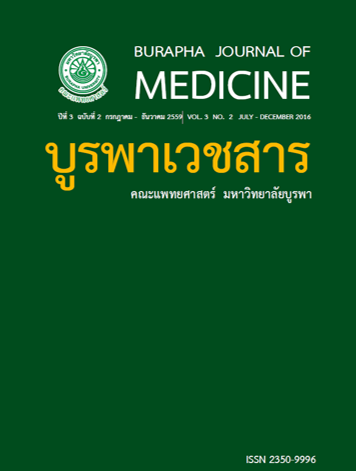การตรวจคัดกรองมะเร็งลำไส้ใหญ่โดยใช้เครื่องเอ็กซเรย์คอมพิวเตอร์ความเร็วสูง ณ โรงพยาบาล มหาวิทยาลัยบูรพา: ประสบการณ์ความพึงพอใจของผู้ป่วย
Main Article Content
บทคัดย่อ
Objective CT colonography (CTC) for screening of colorectal cancer in Thailand is quite a
new method and not popular. Thus we investigated patient satisfaction concerning patients’
understanding for bowel preparation, discomfort during examination, and acceptance.
Design We reviewed questionnaires from all patients who underwent CTC at Burapha University
hospital from 1st July 2013 to 30th June 2016.
Results There were 128 patients, mean age 58.8 years. Eighty patients (62.5%) were female.
All of patients received instructions clearly to very clearly. Of the 128 patients, 91.4% felt mild
to moderate discomfort during the examinations and 68.0% accepted the next examinations.
There were 1.3% non-assessable colonic segments in this study.
Conclusions Most patients satisfied this method because they received clear instructions of the
patient preparation for CTC. This resulted in a good patient co-operation and a well acceptance
for the next examination.
Article Details
References
registry 2011. National cancer institute
2011 [Internet]. [accessed June 10, 2016].
Available from: http://www.nci.go.th/th/
cancer_record/cancer_rec1.html
2. Pickhardt PJ, Kim DH, Meiners RJ, Wyatt KS,
Hanson ME, Barlow DS, et al. Colorectal and
extracolonic cancers detected at screening
CT colonography in 10286 asymptomatic
adults. Radiology 2010; 255:83-8.
3. Burch JA, Soares-Weiser K, St John DJ, Duffy
S, Smith S, Kleijnen J, et al. Diagnostic
accuracy of faecal occult blood tests
used in screening for colorectal cancer:
asystematic review. J Med Screen 2007; 14:
132-7.
4. Allison JE. The role of fecal occult blood
testing in screening for colorectal cancer
[Internet]. Practical Gastroenterology 2007:
20-32. [accessed June 10, 2016]. Available
from: http://www.adph.org/colon/assets/
FOBT_role.pdf
5. Roberts-Thomson IC, Tucker GR, Hewett
PJ, Cheung P, Sebben RA, Khoo EW,
et al. Single-center study comparing
computed tomography colonography
with conventional colonoscopy. World J
Gastroenterol 2008; 14: 469-73.
6. Levin B, Lieberman DA, McFarland B,
Smith RA, Brooks D, Andrews KS, et al.
American cancer society colorectal cancer
advisory group, US multi-society task force,
American college of radiology colon cancer
committee. Screening and surveillance for
the early detection of colorectal cancer
and adenomatous polyps, 2008: a joint
guideline from American cancer society, the
US multi-society task force on colorectal
cancer, and the American college of
radiology. CA Cancer J Clin 2008; 58: 130-60.
7. Burling D. CT colonography standards.
Clinical Radiol 2010; 65: 474-80.
8. Taylor SA, Halligan S, Bartram CI. CT
colonography: methods , pathology and
pitfalls. ClinRadiol 2003; 58: 179-90.
9. Svensson MH, Svensson E, Lasson A, Hellstrom
M. Patient acceptance of CT colonography
and conventional colonoscopy: prospective
comparative study in patients with or
suspected of having colorectal disease.
Radiology 2002; 222: 337-45.
10. Pickhardt PJ. Incidence of colonic perforation
at CT colonography: review of existing
data and implications for screening of
asymptomatic adults. Radiology 2006;
239: 313-6.
11. Callstrom MR, Johnson CD, Fletcher JG,
Reed JE, Ahlquist DA, Harmsen WS, et
al. CT colonography without cathartic
preparation: feasibility study. Radiology
2001; 219: 693-8.
12. Marjolein H. Liedenbaum, A. H. de Vries,
C. I. B. F. Gouw, A. F. van Rijn, S. Bipat,
E. Dekker, et al. CT colonography with
minimal bowel preparation: evaluation
of tagging quality, patient acceptance and
diagnostic accuracy in two iodine-based
preparation schemes. EurRadiol 2010; 20:
367-76.
13. Macari M, Lavelle M, Pedrosa I, et al. Effect
of different bowel preparations on residual
fluid at CT colonography. Radiology 2001;
218: 274-7.

